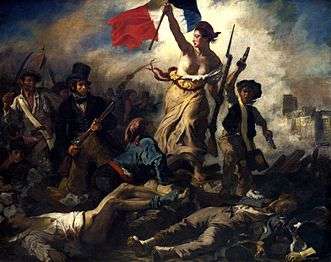Atlantic Revolutions

The Atlantic Revolutions were a revolutionary wave in the late eighteenth and early nineteenth centuries. It was associated with the Atlantic World during the era from the 1770s to the 1820s.
It shook the Americas and Europe, including the United States (1775–1783), France and French-controlled Europe (1789–1814), Haiti (1791–1804), Ireland (1798) and Spanish America (1810–1825).[1] There were smaller upheavals in Switzerland, Russia, and Brazil. The revolutionaries in each country knew of the others and to some degree were inspired by or emulated them.[2]
Independence movements in the New World began with the American Revolution, 1775–1783, in which France, the Netherlands and Spain assisted the new United States of America as it secured independence from Britain. In the 1790s the Haitian Revolution broke out. With Spain tied down in European wars, the mainland Spanish colonies secured independence around 1820.[3]
In long-term perspective, the revolutions were mostly successful. They spread widely the ideals of republicanism, the overthrow of aristocracies, kings and established churches. They emphasized the universal ideals of the Enlightenment, such as the equality of all men, including equal justice under law by disinterested courts as opposed to particular justice handed down at the whim of a local noble. They showed that the modern notion of revolution, of starting fresh with a radically new government, could actually work in practice. Revolutionary mentalities were born and continue to flourish to the present day.[4]
National revolutions
- Corsican Revolution (1755–1769)
- American Revolution (1765–1783)
- Geneva Revolution of 1782
- Revolt of Dutch Patriots (1785)
- French Revolution (1789–1799)
- Liège Revolution (1789–1795)
- Brabant Revolution (1790)
- Latin American wars of independence
- Haitian Revolution (1791–1804)
- Brazilian revolutionary movements
- Minas Conspiracy in Minas Gerais, Brazil (1789)
- Bahian Revolt (Conjuração Baiana) in Bahia, Brazil (1798)
- Pernambucan Revolt in Pernambuco, Brazil (1817)
- Brazilian Declaration of Independence (1821–1824)
- Spanish American wars of independence (1808–1833)
- Argentine War of Independence
- May Revolution (Argentina and neighbouring countries, 1810)
- Chilean War of Independence
- Peruvian War of Independence
- Bolivian War of Independence
- Military career of Simón Bolívar (Northern and Western South America)
- Ecuadorian War of Independence
- Patria Boba (Colombia)
- Venezuelan War of Independence
- Mexican War of Independence
- Argentine War of Independence
- Polish War in the defence of constitution (1792) and Kościuszko Uprising (1794)
- Batavian Revolution (1795)
- Scottish Rebellion (1797)
- Irish Rebellion (1798)
Various connecting threads among these varied uprisings include a concern for the "Rights of Man" and freedom of the individual; an idea (often predicated on John Locke or Jean-Jacques Rousseau) of popular sovereignty; belief in a "social contract", which in turn was often codified in written constitutions; a certain complex of religious convictions often associated with deism or Voltairean agnosticism, and characterized by veneration of reason; abhorrence of feudalism and often of monarchy itself. The Atlantic Revolutions also had many shared symbols, including the name "Patriot" used by so many revolutionary groups; the slogan of "Liberty"; the liberty cap; Lady Liberty or Marianne; the tree of liberty or liberty pole, and so on.
Individuals and movements
- George Washington (United States)
- Thomas Jefferson (United States)
- Benjamin Franklin (United States)
- Sons of Liberty (North America)
- Marquis de Lafayette (France and North America)
- Patriots (Netherlands)
- Société des Amis des Noirs (France)
- Napoleon Bonaparte (France and most of Europe)
- Richard Price and Joseph Priestley (Great Britain)
- Jacobin Club (France, 1789–1794)
- Lautaro Lodge
- Maximilien Robespierre (France)
- Society of United Irishmen (Ireland, 1791–1804)
- Thomas Paine (Great Britain and North America)
- Society of the Friends of the People (Great Britain, 1792-)
- Society of the United Scotsmen (Scotland)
- Society of the United Englishmen
- Wolfe Tone (Ireland)
- Toussaint Louverture in Haiti
- London Corresponding Society (London)
- Francisco de Miranda
- Société des Fils de la Liberté (Québec)
- Tadeusz Kościuszko
- Inconfidência Mineira (Brazil, 1789)
- Conjuração baiana (Brazil, 1798)
- Simón Bolívar (Venezuela, Colombia, Ecuador, Peru, Bolivia)
- José de San Martín (Argentina, Chile, Peru)
- José María Morelos (Mexico)
- Miguel Hidalgo y Costilla (Mexico)
See also
- Atlantic history, on historiography
Notes
- ↑ Wim Klooster, Revolutions in the Atlantic World: A Comparative History (2009)
- ↑ Laurent Dubois and Richard Rabinowitz, eds. Revolution!: The Atlantic World Reborn (2011)
- ↑ Jaime E. Rodríguez O., The Independence of Spanish America (1998)
- ↑ Robert R. Palmer, The Age of the Democratic Revolution: A Political History of Europe and America, 1760–1800. (2 vol, 1959–1964)
References
- Geggus, David P. The Impact of the Haitian Revolution in the Atlantic World (2002)
- Jacques Godechot. France and the Atlantic revolution of the eighteenth century, 1770–1799 (1965)
- Gould, Eliga H. and Peter S. Onuf, eds. Empire and Nation : The American Revolution in the Atlantic World (2004)
- Greene, Jack P., Franklin W. Knight, Virginia Guedea, and Jaime E. Rodríguez O. "AHR Forum: Revolutions in the Americas", American Historical Review (2000) 105#1 92–152. Advanced scholarly essays comparing different revolutions in the New World. in JSTOR
- Klooster, Wim. Revolutions in the Atlantic World: A Comparative History (2009)
- Palmer, Robert. The Age of Democratic Revolutions 2 vols. (1959, 1964)
- Polasky, Janet L. Revolutions without Borders (Yale UP, 2015). 392 pp. online review
- Sepinwall, Alyssa G. "Atlantic Revolutions", in Encyclopedia of the Modern World, ed. Peter Stearns (2008), I: 284 – 289
- Verhoeven, W.M. and Beth Dolan Kautz, eds. Revolutions and Watersheds: Transatlantic Dialogues, 1775–1815 (1999)
